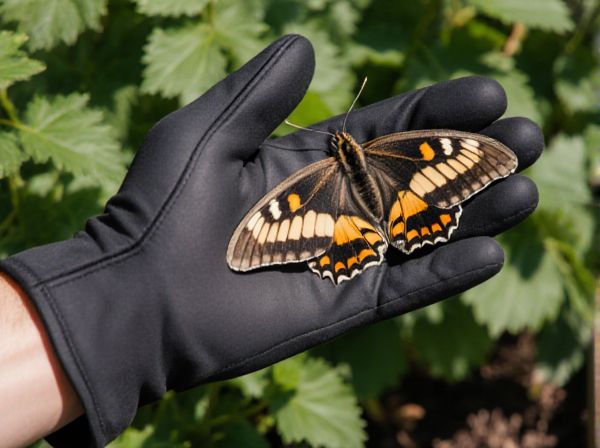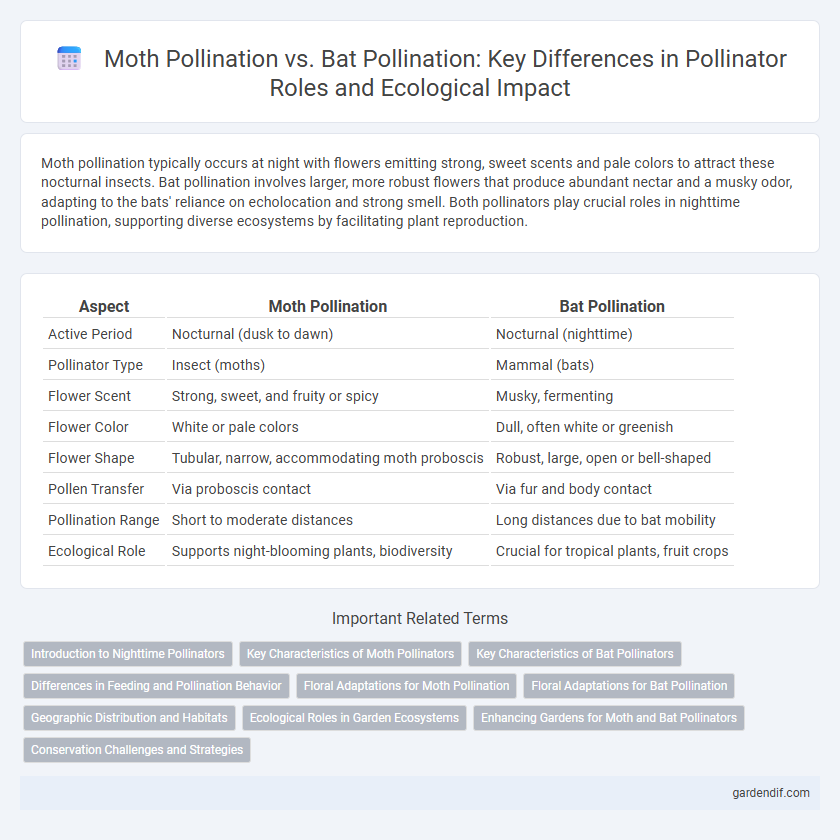
Moth pollination vs Bat pollination Illustration
Moth pollination typically occurs at night with flowers emitting strong, sweet scents and pale colors to attract these nocturnal insects. Bat pollination involves larger, more robust flowers that produce abundant nectar and a musky odor, adapting to the bats' reliance on echolocation and strong smell. Both pollinators play crucial roles in nighttime pollination, supporting diverse ecosystems by facilitating plant reproduction.
Table of Comparison
| Aspect | Moth Pollination | Bat Pollination |
|---|---|---|
| Active Period | Nocturnal (dusk to dawn) | Nocturnal (nighttime) |
| Pollinator Type | Insect (moths) | Mammal (bats) |
| Flower Scent | Strong, sweet, and fruity or spicy | Musky, fermenting |
| Flower Color | White or pale colors | Dull, often white or greenish |
| Flower Shape | Tubular, narrow, accommodating moth proboscis | Robust, large, open or bell-shaped |
| Pollen Transfer | Via proboscis contact | Via fur and body contact |
| Pollination Range | Short to moderate distances | Long distances due to bat mobility |
| Ecological Role | Supports night-blooming plants, biodiversity | Crucial for tropical plants, fruit crops |
Introduction to Nighttime Pollinators
Moth pollination, or phalaenophily, primarily involves nocturnal moths attracted to pale or white flowers emitting strong, sweet fragrances at night, facilitating the transfer of pollen in various ecosystems. Bat pollination, known as chiropterophily, occurs when nectar-feeding bats visit large, sturdy flowers featuring ample nectar, often with musky or fermented scents, supporting pollination in tropical and desert environments. Both moths and bats serve as crucial nighttime pollinators, enabling plant reproduction under low-light conditions and maintaining biodiversity in their respective habitats.
Key Characteristics of Moth Pollinators
Moth pollinators are primarily nocturnal insects with a strong attraction to pale or white flowers that emit sweet, musky scents during the night. Their long, slender proboscis allows them to access deep, tubular flowers, facilitating effective pollination of plants such as yucca and evening primrose. Moths exhibit rapid, hovering flight patterns and are sensitive to subtle floral cues like ultraviolet patterns, which differentiate them from bat pollinators that rely more on echolocation and emit stronger odors.
Key Characteristics of Bat Pollinators
Bat pollinators exhibit nocturnal activity patterns, relying on echolocation to locate flowers with strong, musky scents and large, pale-colored petals that facilitate nighttime visibility. These key characteristics include specialized long snouts and tongues to access deep nectar sources, as well as robust bodies that enable efficient pollen transfer between plants. Unlike moths, bats tend to pollinate flowers with higher nectar volumes, supporting their substantial energy needs during flight.
Differences in Feeding and Pollination Behavior
Moth pollination primarily occurs at night with moths using their long proboscis to extract nectar from deep tubular flowers, often hovering in place similar to hummingbirds. Bat pollination involves larger, nocturnal bats feeding on nectar, pollen, and sometimes fruit from robust, bowl-shaped flowers that emit strong fragrances to attract these mammals. Differences in feeding mechanics influence pollination patterns, as moths transfer pollen via fuzzy body parts while bats rely on facial and wing contact with reproductive floral structures.
Floral Adaptations for Moth Pollination
Floral adaptations for moth pollination typically include pale or white-colored flowers that enhance visibility in low light conditions and emit strong, sweet fragrances during nighttime to attract moths. These flowers often have long, narrow corolla tubes that accommodate the moths' elongated proboscises, facilitating efficient nectar access and pollen transfer. Unlike bat-pollinated flowers, which are usually robust and open at night with large quantities of nectar, moth-pollinated flowers demonstrate more delicate structures optimized for the moths' slender morphology and nocturnal activity patterns.
Floral Adaptations for Bat Pollination
Floral adaptations for bat pollination include large, sturdy flowers with pale or white colors that enhance visibility in low light and emit strong, musky scents to attract nocturnal bats. These flowers often produce copious amounts of dilute nectar, providing ample energy to support bat foraging activity. Unlike moth-pollinated flowers, which tend to have narrow corollas and sweet fragrances, bat-pollinated plants exhibit robust structures that withstand bat contact and facilitate pollen transfer through large anthers and stigmas.
Geographic Distribution and Habitats
Moth pollination primarily occurs in temperate and tropical regions, with moths favoring open habitats such as meadows, forests, and gardens where night-blooming flowers emit strong fragrances. Bat pollination is concentrated in tropical and subtropical areas, especially in deserts, rainforests, and caves, where flowering plants produce large, sturdy blossoms adapted for bat access. Both pollinators play crucial ecological roles, with moths thriving in diverse environments and bats specializing in pollinating nocturnal flowers in warm climates.
Ecological Roles in Garden Ecosystems
Moth pollination enhances nocturnal garden ecosystems by supporting plant species that bloom at night, facilitating nutrient cycles and promoting biodiversity through specialized plant-pollinator interactions. Bat pollination contributes significantly to seed dispersal and the reproduction of night-flowering plants, playing a critical role in maintaining forest structure and genetic diversity within garden habitats. Both moths and bats ensure the stability of ecological networks by sustaining diverse plant populations and supporting other wildlife dependent on these floral resources.
Enhancing Gardens for Moth and Bat Pollinators
Moth pollination thrives with night-blooming flowers emitting strong, sweet fragrances that attract nocturnal moths, making gardens rich in white or pale-colored blossoms ideal. Bat pollination requires large, robust flowers with ample nectar and fruity or musky scents suited for bats' sensory preferences, benefiting from planting native fruit-bearing trees and dense foliage for roosting. Enhancing gardens with diverse plant species that bloom at night and provide shelter supports both moth and bat populations, crucial for maintaining healthy ecosystems and improving pollination efficiency.
Conservation Challenges and Strategies
Moth pollination faces conservation challenges such as habitat loss and light pollution, which disrupt nocturnal activity patterns essential for successful pollination. Bat pollination is threatened by habitat destruction, disease like white-nose syndrome, and human disturbance, necessitating strategies like habitat restoration and protection of roosting sites. Conservation efforts for both pollinators emphasize maintaining native plant diversity and minimizing artificial lighting to support their ecological roles.
Moth pollination vs Bat pollination Infographic

 gardendif.com
gardendif.com